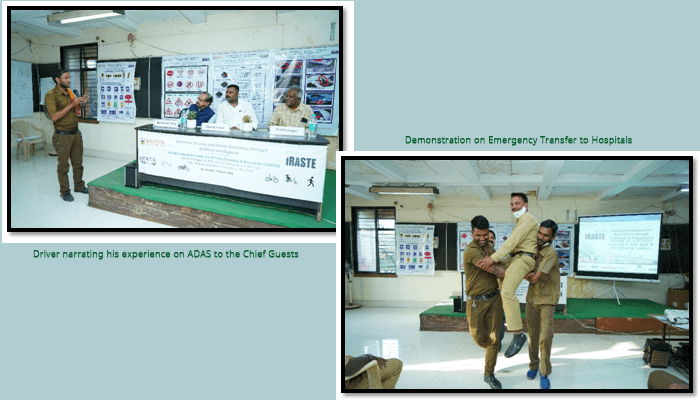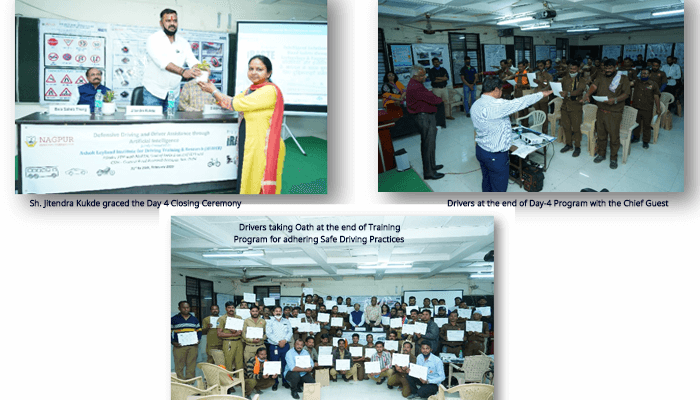Technological innovations such as Advanced Driver Assistive Systems (ADAS) can help in reducing road accidents by promoting defensive driving behaviours. Aiming to reinforce these skills via periodical driver training programmes, Project iRASTE kicks off the first such initiative.
If you’ve ever been in a speeding cab en route to the airport, chances are you’ve experienced the annoying beeping that alerts the driver of going over the speed limit. A speeding alert much like the automatic emergency braking system, backup cameras, blindspot detection and others was among the earliest technologies made available to help in averting road accidents. However with the emergence of AI and predictive analytics, assistive driving technology is way more sophisticated warning us not only of accidents well before they take place, but also enabling us to fix pitiful road infrastructure that often lies at the heart of the casualties.
iRASTE in Nagpur
In September 2021, the Union Minister of Road Transport Nitin Gadkari kicked off an AI-powered road safety project in Nagpur titled iRASTE – an acronym for Intelligent Solutions for Road Safety through Technology and Engineering. It is a unique collaborative initiative between the government (Central Road Research Institute and Nagpur Municipal Corporation), industry (Intel and Mahindra & Mahindra) and academia (INAI and IIITH) towards advancing road safety. As a pilot project aiming to reduce road fatalities upto 50% in Nagpur city by 2023, the Nagpur Municipal Corporation (NMC) has adopted the AI-tech in its fleet of intra-city buses. Vehicle safety, mobility analysis and road infrastructure safety form the cornerstones of the project. In order to improve vehicle safety, NMC recently conducted a driver training programme titled “Defensive Driving and Driver Assistance through Artificial Intelligence”, especially targeting drivers of large commercial vehicles such as buses. This was done with the assistance of Ashok Leyland Institute for Driver Training And Research (ALIDTR) where nearly 340 drivers were trained over the course of 6 days.

Training Sessions
Defensive driving is a strategy that goes well beyond mere following of road laws and regulations. It involves the conscious practice of safe driving techniques in a bid to pre-empt accidents. Some of the simplest ways are by allowing enough space between you and the vehicle ahead of you, eliminating distractions, looking beyond the vehicle immediately in front of you and so on. However all this assumes a certain level of awareness in the driver. Therefore, the training programme opened with an interactive session on psycho-physical traits and road rage aspects that were covered by Dr. Neelima Chakrabarty of CSIR-CRRI. This was followed by presentations on safe driving practices and defensive training by ALIDTR.
With a large part of iRASTE’s technology based on Advanced Driver Assist System (ADAS), a team from Intel India showcased the usefulness of ADAS technology to the drivers. They also solicited feedback on the experience of ADAS devices that have been installed so far in the buses to understand issues faced, if any and also to improve the overall driving experience. Most drivers remarked that the alerts provided by the Collision Avoidance Systems helped in promoting defensive driving behaviours such as lane discipline and adherence to the speed limits. In addition to this, a subset of drivers was selected to undergo the Vienna Test. This was done to understand the individual reactions which would in turn be helpful in fine tuning the Collision Avoidance System.
Can technology promote safe driving behavior ? Listen in to hear driver experience with AI-based Collision Avoidance Systems. Re-imagine Road Safety with the predictive power of AI. @ngpnmc @CSIRCRRI @IntelIndia @MahindraRise @iiit_hyderabad @IHUB_Data @kishramiset pic.twitter.com/WfILVbsbKj
— inai.ai (@inai_ai) March 1, 2022
Reinforcing Safe Driving
Explaining the rationale behind such training, Varma Konala, CEO, INAI, says, “At the end of the day the effectiveness of technology depends on how well the users are adopting it. In this case it is particularly relevant because drivers have certain well-ensconced driving habits based on how long they’ve been driving. So now, when we introduce a new AI-based element into their daily routine, we need to first explain it to them and keep reinforcing it on a regular basis because we’re trying to affect a behaviour change. When drivers continually hear alerts from a device that can potentially avoid accidents, over a period of time, they’ll get habituated and start ignoring it. We need to periodically have these kind of refresher courses where we emphasise all the aspects of safe driving so that the drivers start paying attention again”.

Sarita Chebbi is a compulsive early riser. Devourer of all news. Kettlebell enthusiast. Nit-picker of the written word especially when it’s not her own.


Next post